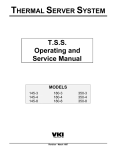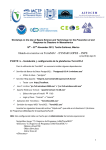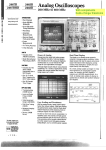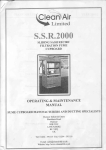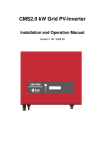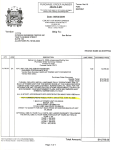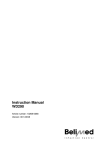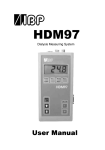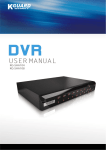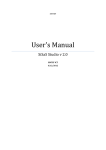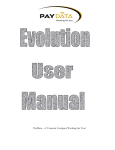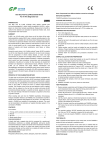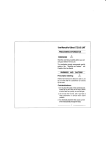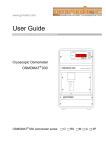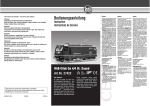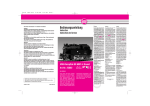Download Memorandum - The New York Times
Transcript
~~JI4~~ FOOD AND DRUG ADMINISTRATION
Memorandum
DATE:
June 6, 2007
FROM:
Joshua C. Nipper, Biomedical Engineer
Gastroenterology and Renal Devices BranchIDRARD, HFZ-470
SUBJECT:
K070320/Sl -Traditional 5 10(k)
Edwards Aquarius System
Edwards Lifesciences Services, Gmbh
Robert Madjno
Director of Regulatory and Quality Affairs
Edwards Lifesciences Services, Gmbh
Edisonstrasse 6
85716 Unterschleissheim
Germany
Phone: +49 89 95475 203
Fax: +49 89 95475 301
Email: robert madjno~edwards.com
BACKGROUND
This is my second review of this traditional 5 10(k) submission. The first review resulted in the
file being placed on telephone hold (via email) on April 17, 2007. This submission attempts to
address the deficiencies that were identified in that email. The proposed device is the Aquarius
System, manufactured by Edwards Lifesciences Services, Gmbh ("Edwards" or "the firm"). The
proposed device is regulated under 21 CFR §876.5860, high permeability hemodialysis delivery
system, and is a Class II device. The product code for this device is 78-KDI. The general
requirements for these devices are outlined in the FDA guidance document "Gilidance for
Industry and CDRH Reviewers onthe Content of Premarket Notifications for Hemodialysis
Delivery Systems: _Final". The firm has stated that the proposed device is built on ~the sa~me
framework (hardware and software) and the Baxter Accura System (K02 1615), which they are
using as their primary predicate device.
INDICATIONS FOR USE
As stated by the firm, "The Edwards Aquarius System in indicated for continuous solute and/or
fluid removal in patients with acute renal failure of fluid overload. The Edwards Aquarius
system may also be used in Therapeutic Plasma Exchange (TPE) therapies. The Edwards
Aquarius system is indicated for use in a clinical setting and not forhome use." With the
exception of the addition of the last sentence, this indication for use is identical to the Baxter
Accura System.
DEVICE DESCRIPTION
The Aquarius system is considered a hemodialysis delivery system intended for continuous renal
replacement therapy (CRRT). The Aquarius is capable of delivering the following types of
CRRT:
*
Slow Continuous Ultrafiltration (SCUF): Provides fluid removal via ultrafiltration. A fluid
flow diagram for SCUF therapy has been provided on page 11.13 of the original
submission.
* Continuous Veno-venous Hemofiltration (CVVH): Provides convective solute clearance by
hemofiltration. Net fluid removal (ultrafiltration) can also be prescribed during CVVH.
CVVH can be performed using either pre-dilution (e.g., infusion of fluid before the blood
pump), post-dilution (e.g., infusion of fluid after the blood pump), or a combination of the
two. A fluid flow diagram for CVVH therapy has been provided on page 11.14 of the
original submission.
* Continuous Veno-venous Hemodialysis (CVVHD): Provides diffusive solute clearance by
hemodialysis. Net fluid removal (ultrafiltration) can also be prescribed during CVVHD. A
fluid flow diagram for CVVHD therapy has been provided on page 11.15 of the original
submission.
• Continuous Veno-venous Hemodiafiltration (CVVHDF): Provides solute clearance by both
convection and diffusion. Net fluid removal (ultrafiltration) can also be prescribed during
CVVHDF. Fluid infusion during CVVHDF can only be performed using post-dilution. A
fluid flow diagram for SCUF therapy has been provided on page 11.16 of the original
submission.
* Therapeutic Plasma Exchange (TPE): Provides plasma exchange through membrane based
filtration. A fluid flow diagram for TPE therapy has been provided on page 11.17 of the
original submission.
The Aquarius system is a hemodialysis delivery system developed by MeSys in Germany, and is
virtually identical to the Baxter Accura System (K021615). The Aquarius is built on the same
hardware framework as the Accura, with relatively minor changes (discussed in the comparison
section below). The firm has stated that the software of the Aquarius has been updated since the
clearance of the Accura. In order to perform the treatment, the Aquarius leads the caregiver
through 9 treatment modes: System Test -> Preparation -> Priming -> Clamp and Pressure Test
-> Recirculation --> Connect Patient -> Treatment -> Disconnect Patient -- End Treatment. In
order to achieve these functions, the Aquarius utilizes the following component:
*
*
·
Blood Pump - The blood pump can be set from 30 mL/min to 450 mL/min, or from 10
mL/min to 200 mL/min when the Aquarius is operating in "low flow" mode. The blood
pump is responsible for pumping the blood from the patient's access, through the filter, and
back to the patient. It should be noted that the Aquarius system can only operate in "double
needle" mode.
Filtration Pump - The filtration pump is responsible for pumping any effluent and/or used
dialysate from the filter and into the filtration collection bag.
Pre-dilution substitution pump - The pre-dilution pump is responsible for pumping
substitution fluid from the bag on the scale into the blood tubing line prior to the blood
pump. The pre-dilution pump does not run during SCUF or TPE, may or may not be used
Page 2 of 11- Lead Review of 510(k) Application K070320/Sl - Edwards Lifesciences, Gmbh
Edwards Aquarius System
*
·
*
*
*
*
*
*
*
during CVVH, and is used as a dialysate pump during CVVHD and CVVHDF. For CVVH,
the pre-dilution and post-dilution pump rate cannot exceed 10 L/hour.
Post-dilution substitution pump - The post-dilution pump is responsible for pumping
substitution fluid from the bag on the scale into the blood tubing line after the blood pump.
The post-dilution pump does not run during SCUF or CVVHD, may or may not be used
during CVVH, and is used for solution infusion during CVVHDF and TPE.
Pressure Sensors - The Aquarius system has a pressure pod on the blood tubing line before
the blood pump (Access Pressure), after the blood pump but before the filter (Pre-Filter
Pressure), and immediately following the filter (Return Pressure). An additional pressure
sensor is located on the filtrate line, following the blood leak detector. Transmembrane
pressure (TMP) is calculated using the equation: TMP - ((Return pressure + Pre-Filter
Pressure)/2 - Filtrate Pressure).
Anticoagulant Pump - The anticoagulant pump is a dc linear pump, designed to pump
heparin into the blood line, after the blood pump, at a programmed rate ranging from 0 to 15
mL/hour. A heparin bolus of 0 to 2.5 ml/hour can also be programmed.
Balancing System - The balancing system uses two 25 kg scales along with the measured
pump speeds to balance the fluid level of the patient. The system will alarm if there is a 50
g discrepancy, or a 2 0g discrepancy when in "low flow" mode. The actual fluid loss of the
patient is measured every second, and the substitution and filtration pumps are sped up or
slowed down if the actual fluid loss is higher or lower than the expected fluid loss (page
16.37).
Heater - The Aquarius system contains a plate heater that heats substitution and/or dialysate
solution. The heater can be programmed to heat the solutions from 34 to 39 °C, and can
heat up to 6L /hour. The Aquarius system monitors the heater and alarms if the fluid
reaches 41 "C or the plate heater reaches 53 °C.
Air Detector / Blood Saline Detector - The air detector is an ultrasonic detector designed to
detect the presence of air in the return blood line. The air detector will trigger an alarm if a
20 gL air bubble is detected at a blood flow rate of 200 ml/min, or 20 pL of "foam" is
detected in a I minute interval. The housing for the air detector also has an infrared LED
used to detect if the tubing is seated correctly, and if blood is present in the tubing. This
feature is only used to initiate treatment.
Return Line Clamp - The return line clamp is located immediately before the return to the
patient access, and prevents blood from being re-infused to the patient during some alarm
conditions (e.g., air in the tubing).
Software / Graphical User Interface (GUI) - The Aquarius System, like most modern
hemodialysis delivery systems, is a software controlled system with a GUI. The user
interacts with the system software using a pressable scroll wheel and series of other buttons
on the face of the machine. The GUI is pretend on a 10.4" thin film transistor (TFT) full
color monitor. The system also has a red, yellow, and green LED at its top to signal the
therapy status to the health care provider.
Blood Tubing - Edwards has specifically noted that the blood tubing for this system is not
included in this 510(k) submission. The blood tubing for this device was cleared under
K063293, and was cleared on March 23, 2007.
Page 3 of 11- Lead Review of 510(k) Application K070320/Sl - Edwards Lifesciences, Gmbh
Edwards Aquarius System
in case of fault conditions, the system has an audible and visual alarm. The audible alarm is 65
dB at I meter, and can be muted for up to 2 minutes. However, if a second alarm occurs while
muted, that alarm will sound.
COMPARISON TO PREDICATE
As previously noted, the Aquarius system is virtually identical to the Baxter Accura System
(K02j1615). The firm has also compared their device to the Gambro Prisma System (K993064,
K981681, and K946279), and the B.Braun Diapact System (K973322). The primary differences
between the Aquarius and the Accura are the addition of the low blood flow feature, the addition
of the automatic degassing unit, updated software, and a turnable hook system on the scales for
easier loading of solutions. A comparison between the Aquarius and the Accura can be seen in
Table 1 below.
Table 1: Comparison between the proposed and predicate devices
Edwards Aquarius
Baxter Accura
510(k) number
This Submission
K021615
Available treatment modalities
SCUF, CVVH, CVVHD,
SCUF, CVVH, CVVID,
CVVHDF, TPE
CVVHDF, TPE
Air detection sensitivity
- 20 }aL
- 20 [tL
Blood leak detections sensitivity
> 0.2 mL blood/min ( 32% Hct
> 0.2 mL blood/mmin (&32% Hct
Bloodflow raterange (mI/mm)
30 - 450 or 10 - 200 (low flow)
30 450
Blood flow accuracy
10%
10%
Scales
Strain gauge capacity <•20 kg ±
Strain gauge capacity < 20 kg t
0.25%
0.25%
Anticoagulant syringe size (ml)
30or50
30 or 50
Heparin delivery
0; I to 15 ml/h continuous or 0.5 to 0; I to 15 mil/h continuous or 0.5 to
2.5ml bolus
2.5ml bolus
Fluid pumps
Pre-dilution/dialysate, PostPre-dilution/dialysate, Postd__
,iuluton, Effluent
__
_dilutionEf'fluent
Pre-Dilution (Dialysate) Pump
0: 100 to 10,000 ml/hr for regular
0: 100-10,000 ml/hr
flow rate*
0:10 to 4,000 mI/hr for low flow
Post-Dilution Pump flow rate*
0:I00 to 10,000 ml/hr for regular
0:100-0,000ml/hr
0: 10 to 4,000 ml/hr for low flow
Replacement methods
Pre-dilution
Pre-dilution
Post-dilution
Post-dilution
Pre+Post (CVVH only)
Pre+PostL(CVVH only)
Effluent pump flow rate (ml/hr)
0:100-12,000 for regular
0: 100-12000
0:1I0-1 1,000 for low-flow
Access pressure measuringrange
-250 to +200 mmHg
-250 to +200 mmHg
Access pressure maxalarm limits
-250 to+1
00 mmHg
Access pressure accurac
± 5mm H
±
5mm Hg
Return pressure measuring range
-50 to +350 mmHg
-50 to +350 mmH
Return pressure max alarm limits
+10 to +300mmHg
±10 to +300 mmlg
Return pressure accuracy
± 5mm H1
± 5mm Hg
Prefilter pressure measuring range
-150 to +500 mmHg
-150 to +500 mm
Prefilter pressure max alarm limits
-100 to
mml
-100
I+500
to +500 mmHg
Prefilter pressure accuracy
±5ra
m Hg
± 5mm Fig
Effluent pressure measuring range
-250to+400mmlg
-450to+400mmHg
Effluent pressure max alarm limits
-200 to +350 mmHg for renal
-400 to +400 mmHg for renal
-200 to +350 mmHg for TPE
-400 to +1 00 mmHg for TPE
Effluent pressure accuracy
± Whom
· 10mm
Hg
Dialysate/ Replacement Heater
Off,35 °Cto39 °C+ 0.3 °C
Off, 35 'C to 39 'C ± 0.3 'C
*Pre-dilution flow rate + post-dilution flow rate must be < 10,000 mL/hr
Page 4 of 11- Lead Review of 510(k) Application K0703201/1 - Edwards Lifesciences, Gmbh
Edwards Aquarius System
Within their comparison to the predicate devices (Section 12 of the submission), the firm has
provided adequate justification for any new or updated features. As such, as long as the proposed
device is adequately tested, it can be considered substantially equivalent (SE) to the predicate
devices identified.
PERFORMANCE TESTING
Verification and Validation (V&V) information, for both software and hardware, was provided in
Section 16.9 of the firm's original submission. This V&V includes component level testing of
the primary components of the device, including: blood pump, pre-dilution pump, post-dilution
pump, filtration pump, return pressure transducer, access pressure transducer, pre-filter pressure
transducer, filtrate pressure transducer, heater, filtrate / substitution scale, air detector, venous
clamp, blood leak detector, heparin pump, battery, automatic degassing unit, and power supply.
System level testing, including alarm verification, has also been provided. For these tests,
Edwards provided the test identification number, a summary of the testing procedure, the
expected results, and whether or not the device passed the testing. Additional testing on software
specific faults, e.g. faults related to the microprocessor, RAM, or EEPROM chips, was also
provided. The firm indicated that the proposed device passed all of the listed testing.
The firm addressed the risks identified in their hazard analysis, and provided traceability to the testing
plan provided in Section 16.9 of the original submission. The risks identified by the firm are
appropriate for this type of hemodialysis delivery system (e.g., CRRT). In the April 17, 2007, email
to the firm, they were asked to provide the complete testing protocols and test results for any mock
treatments. The firm has provided this information in Attachment 5 of this submission. Review of
the testing protocols confirms that the performance (bench) testing conducted on the proposed
device is adequate to support a substantial equivalence determination.
Electrical and EMC
In Section 17 of their original submission, Edwards provided conformity to IEC 60601-1 for
electrical safety and LEC 60601-1-2 for electromagnetic compatibility (EMC). The device passed
this testing. The electrical and EMC testing for the proposed device can be considered
acceptable.
SOFTWARE
Edwards has submitted software documentation in Section 16 of their original submission. In
general, the firm has followed the recommendations of the FDA guidance document "Guidance
forthe Content of Premarket Submissions for Software Contained in Medical Devices Guidance forIndustryandFDAStaff." Each of the elements from the guidance document is
discussed below.
Level of Concern
In Section 16.1 of their original submission, the firm has correctly identified the proposed
software as a "Major" level of concern. Given that the proposed device could cause serious
injury or death, I concur that the software should be considered a "Major" level of concern.
Page 5 of 11- Lead Review of 510(k) Application K070320/S1 - Edwards Lifesciences, Gmbh
Edwards Aquarius System
U-
Software Description
Edwards has provided a basic description of the software in Section 16.1 of their original
submission. This information is supplemented by the rest of the submission, including general
device description, predicate comparison, and device labeling. Like most hemodialysis delivery
systems, and compliant with IEC 60601-2-16, the Aquarius software uses independent software
programs and processors to control and monitor the device. The proposed software also contains
a third independent program for the display. The names assigned for these software programs are
"Master", "Controller", and "Display", respectively.
The functions of the Master software are to control all components of the device and keyboard
inquiries as well as to generate and display data. The Master software also controls the main
program flow, steers all measuring and regulating units, and is responsible for independently
monitoring the Controller software. The Controller software independently monitors many of the
measurement results, and compares the values obtained to those being used by the Master
software. The Controller software is also responsible for triggering all alarm conditions. The
Display software is used to obtain information from the Master software and display it to the user
in the form of a graphical user interface (GUI). The GUI of the Aquarius system is virtually
identical to that of the Baxter Acura System, and contains on-screen prompts for device setup,
programming, general use, troubleshooting, and therapy termination.
The Master and Controller programs were written using "C", and the Display software was
written using Pascal. Identification of the specific hardware / microprocessors that the software
runs on has been provided in Section 16.2.2 of the original submission.
Software Hazard Analysis
The firm has conducted a hazard analysis using the FDA accepted ISO 14971 methodology. Two
separate analyses were conducted; the first includes a listing of risks, potential causes,
probability, and severity before mitigation, and the second includes a listing of the mitigation
techniques as well as the residual risk levels. The risk analyses conducted by the firm included
both hardware and software based failures, and includes all of the relevant risks for hemodialysis
delivery systems (e.g., improper therapy, blood loss, air infusion, etc.). The risk analyses
conducted by the firm can be considered acceptable for their intended purpose.
Software Requirements Specifications (SRS)
Edwards has provided the SRS information in Section 16.4 of their original submission. Each
requirement is specifically defined, and adequate information has been provided regarding
algorithms used and program logic / flow. The SRS provided by the firm are somewhat high
level for device of major level of concern, but can be considered acceptable for their intended
use.
Architecture Design Charts
Edwards has provided information regarding the system architecture in Section 16.5 of their
original submission. This information is provided primarily in graphical format, but contains
adequate information to interpret the logic of the software. As previously noted, the software is
sub-divided into three separate programs, each running on an independent microprocessor. The
"Master" program is responsible for the primary operation of the device, while the "Controller"
program is responsible for monitoring the Master program and taking protective action in the
Page 6 of 11- Lead Review of 510(k) Application K070320/Sl
Edwards Aquarius SystemI
-
Edwards Lifesciences, Gmbh
case of an alarm situation. Block diagrams of the functions controlled by the Master and
Controller have been provided on pages 16.209 through 16.211 of the original submission. The
"Display" program communicates with the Master system to provide the user the graphical user
interface (GUI), and translates physical key presses from the user back to the Master software.
The three software programs communicate using the RS232 serial interface. The firm has
provided adequate information regarding the architecture of the proposed software.
Software Design Specifications (SDS)
Edwards has provided their SDS information in Section 16.6 of their original submission. This
information includes a "Software Implementation Plan" (1 6.6. 1), a "Software Module
Nomenclature" (16.6.2), and a"Software RequirementslImplementation" (16.6.3). The first
document identifies the name and primary function of each software module in the 3 programs.
The second document identifies the naming conventions used during the creation of the software.
Finally, the third document provides traceability between the SRS and the specific modules of
the software that implement each requirement. The firm has provided adequate
documentation regarding the SDS.
Traceability Analysis
The firm has included a traceability analysis in Section 16.7 of their original submission.
Separate analyses have been provided for the functional requirements specification (e.g., the
system as a whole) and the SRS. Each of these analyses link the specific requirements to the
verification or validation process used to demonstrate that the requirements are met. The firm
also provided an analysis linking the risk analysis to the verification and validation activities.
Ideally, a single traceability analysis would have been provided; however, the information
provided by the firm is thorough, and can be considered acceptable for its intended use.
Development Plan
The firm has provided information regarding their hardware and software development plan in
Section 16.8 of their original submission. This information included a definition of the general
phases of the Aquarius project, and depictions of the cyclical development model used for the
system software. The firm also provided an annotated list of control documents generated during
the development process, as well as a copy of the coding standards used to create the software.
The information regarding the development plan of the proposed device provided by the
firm can be considered acceptable.
Verification, Validation,and Testing
All software VV&T provided for the proposed software was provided as system level testing,
and is discussed in the "Performance Testing" section above.
Revision Level Histor
The firm has provided a revision level history starting at version 2.0 (the last common software
version with the Baxter Accura) is Section 16. 10 of their original submission. Included in this history
is each software release version, including specific versions numbers for the master, control, and
display software. A basic description of the changes made for each version has also been included in
this section. Upon request, the firm has clarified that the release date for this version of the software
was January 26, 2007. Edwards has adequate information regarding the revision level history
for this software.
Page 7 of 11- Lead Review of 510(k) Application K(0703201S1
Edwards Aquarius System
-
Edwards Lifesciences, Gmbh
Unresolved Anomalies (bugs)
Edwards has identified five unresolved anomalies in the current version of software (Section
16.11 of the original submission). They included a description of each anomaly, as well as a
rationale regarding why they do not believe the anomaly affect the safety of the device. One
issue identified as an anomaly, UA-005, involves balance alarms being generated if one of the
fluid lines is clamped. If the line remains clamped, the balance alarm will repeat, which can
eventually lead to excessive ultrafiltration form the patient. While this issue can be considered a
safety concern, it is more of a training / human factors issue, and not technically a software
anomaly. The other bugs listed by the firm should not have an affect on the safety of efficacy of
the device. Therefore, the information provided by the firm can be considered acceptable.
STERILITY, PACKAGING & BIOCOMPATIBILITY
The only patient contacting portion of this device / system is the Edwards Aqualine Sterile
Tubing Sets, which has been submitted under a separate 510(k) currently under review
(K063293). As such, there are no issues regarding sterility, biocompatibility, shelf life, or
packaging with this 510(k) submission.
DEVICE LABELING
Edwards has provides a copy of the draft labeling for the Aquarius System in Section 13 of their
original submission. They have also included information regarding the screen layout and a
matrix of the messages that will be on the GUI during given situations. The User's manual for
the Aquarius System is through, and contains the following sections:
1.
2.
3.
4.
5.
6.
7.
8.
9.
10.
11.
How to Use this Manual
Getting Started with Aquarius
Introducing Aquarius
Performing a Treatment with Aquarius
Aquarius Alarms and Messages
Aquarius Technical Data
Guidance and Manufacturer Declaration - Electromagnetic Emissions
Aquarius Cleaning and Disinfection
Aquarius Warranty and Liability
References
Index
The User's Manual for the Aquarius System is virtually identical to the manual for the Baxter
Accura System (K021615). The manual adequately shows how to setup, prime, program,
operate, and troubleshoot the system. It should be noted that much of the setup and
troubleshooting information is also contained in the system GUI, and will available to the user
when they press the "help" button. Baxter has included adequate warnings regarding fluid
composition, including a warning stating that any fluid used as a replacement fluid must be
indicated for intravenous (IV) injection (page 13.18). They have also included adequate
warnings regarding kinked tubing (page 13.62). In the previous review, several minor labeling
deficiencies were identified (see below). Edwards has addressed these deficiencies, so the
proposed labeling can now be considered acceptable.
Page 8 of 11- Lead Review of 510(k) Application K070320/S1 - Edwards Lifesciences, Gmbh
Edwards Aquarius System
ADMINISTRATIVE
StOCK) INFORMATION
The firm has included a 510(k) summary, a truthful and accurate statement, and an indications for use
statement on a separate page. This information is acceptable.
PREVIOUS DEFICIENCIES
The following deficiencies were noted during the course of this review. The firm was notified of
the following deficiencies (italic font) in an email to their primary contact on April 17,2007. A
summary of the firm's response follows·each deficiency.
I. Please provide additional details regarding the software algorithm used to monitor patient
.fluid balance. These details should include information regarding how the "Master" and
"Controller" software interact with the system scales andfluid pumps to balance fluid, as
well as monitoring and controlling system alarm limits. In addition, please provide
additional information regarding the potential affect ofcumulative fluid balance alarms and
how your proposed device mitigates risk to the patient.
Edwards has provided additional information regarding their fluid balance algorithms in Attachment
I of this submission. The Master and Controller software programs monitor the system scales and
compare the actual change in weight (and therefore fluid) to the prescribed change in weight. The
software then uses straightforward linear relationships to scale the pump speeds up or down to
maintain appropriate fluid balance. The system is designed to alarm when the fluid discrepancy
reaches 50mL (g), or 20mL when using "low flow." In their submission, the firm has acknowledged
that ifthe fluid balance alarms are not adequately resolved, the patient could be at risk due to
excessive ultrafiltration, similar to the issue causing the recall of the Gambro Prisma System.
Edwards has attempted to mitigate this risk using the graphical user interface of the system, and
system labeling. On page 80 of99 of their User's Manual, they have a warning that states:
"If repeated balance alarms occur, stop treatment to protect the patient from excessive fluid removal
or overload. Call technical support to resolve the problem. Do not use the machine until it has been
repaired. If the issue cannot be immediately resolved, end the treatment and remove Aquarius from
use until the device is properly calibrated by an Edwards Lifesciences certified technician."
Edwards has provided the information that was requested. Unfortunately, like many CRRT
devices on the market, the Aquarius system may be prone to excessive filtration due to user error,
which can ultimately result in serious injury or death to the patient. The firm will need to ensure that
the users of the Aquarius are well trained regarding the use of the device, with particular attention to
fluid balance issues.
2. Please address the following concerns regarding the User's Manualfor your proposed
device, and provide updated labelingfor FDA review:
a. The indications for use in the user's manual (page I3.8) should match the indications
for use you providedfor Attachment 4.
The firm revised the indications for use in the user's manual to match to proposed indications for use.
Edwards has adequately addressed this deficiency.
Page 9 of 11- Lead Review of 510(k) Application K070320/S1 - Edwards Lifesciences, Gmbh
Edwards Aquarius System
1'-1
b. The statement "Important: The Anticoagulantpump is designed for heparin only"
should be moved from a contraindicationto a warning.
Edwards has moved this statement from a contraindication to a warning.
c. You have identified several issues and "Exceptions" to labeling requirements in the
document entitled "OperatorsManual Validation - Final Report" (staring on page
16 689). Please address these issues.
d. There are several typographicaland grammaticalerrors in the labeling, presumably
due to translationalissues. Please address these issues.
The firm has corrected the "Exceptions" to the labeling and has edited the manual for content, clarity,
and grammar. The labeling for the proposed device can now be considered acceptable.
3. Please identify the release date Ibr software version 6.00.04.
The firm has clarified that the release date for this version of the software was January 26, 2007.
Edwards has adequately addressed this deficiency.
4. On page 13.20 ofyour submission, you have provided users instructions on how to set the date
and time of the system software of the proposed device. In light (i/the recent energy bill passed
by Congress in August 2005 that included extending Daylight Saving Time (DST) by about a
month, DST would start the second Sunday of March and end on the first Sunday of November.
Please indicate if the software of the proposed device has been updated to automatically change
./br DST, since prior DST had been the first Sunday in April to the last,Sunday in October. If/not,
pleaseperform a hazard analysis in order to determine whether this issue may have an impact on
the safety or efficacy of the proposeddevice. Finally,ifyou believe the safety or efficacy of the
proposed device may be compromised due to this issue, please clari/j how you intend to mitigate
this risk.
The firm has clarified that no DST adjustments (either using the old or new DST schedule) is
implemented in the software in order to minimize risk. This strategy is acceptable; therefore,
Edwards has adequately addressed this deficiency.
5. For all simulateddevice runs containedin your verification and validationactivities (e.g., device
testing designed to mimic clinical conditions andrun over several hours), please provide the
complete testing protocols and the results/tom this testing.
The firm has provided this information in Attachment 5 of this submission. Review of the testing
protocols confirms that the performance (bench) testing conducted on the proposed device is adequate
to support a substantial equivalence determination. Edwards has adequately addressed this
deficiency.
Page 10 of 11- Lead Review of 510(k) Application K0703201S1 - Edwards Lifesciences, Gmbh
Edwards Aquarius System
6. On page 13.30 ofyour submission, you recommend changing the hemodialysisfilters and blood
tubing after 24 hours, but indicate that the tubing has been testedfor up to 72 hours. FDA
realizes that the blood tubingfor your proposeddevice is not consideredpart of this 510(k)
submission; however, pleaseprovide system level testing to indicate that the proposed device can
be run safely and effectively over the 24 to 72 hour time period
Edwards has provided summaries of their tubing compatibility testing, demonstrating that the
Aquarius system can operate with the cleared tubing for up to 75 hours. Therefore, the firm has
adequately addressed this deficiency.
SUBSTANTIAL EQUIVALENCE DISCUSSION
Yes
1. Same Indication Statement?
No
V
If YES = Go To 3
2. Do Differences Alter The Effect Or Raise New Issues of
Safety Or Effectiveness?
3. Same Technological Characteristics?
If YES = Stop NSE
x
If YES
4. Could The New Characteristics Affect Safety Or
Effectiveness?
=
Go To 5
If YES =Go To 6
5. Descriptive Characteristics Precise Enough?
x
If NO = Go To 8
If YES
=
Stop SE
6. New Types Of Safety Or Effectiveness Questions?
If YES
=
Stop NSE
7. Accepted Scientific Methods Exist?
If NO = Stop NSE
8. Performance Data Available?
x
If NO = Request Data
9. Data Demonstrate Equivalence?
V
Final Decision: SE
Note: See
http://eroom.fda.gov/eRoomReq/Files/CDRH3/CDRHPremarketNotjfication5 l OkProgram/O 4148/F
LOWCHART%20DECISION%20TREE%20.DOC for Flowchart to assist in decision-making
process. Please complete the following table and answer the corresponding questions. "Yes"
responses to questions 2, 4, 6, and 9, and every "no" response requires an explanation.
1. Explain how the new indication differs from the predicate device's indication:
N/A, indications for use are the same.
2.
Explain why there is or is not a new effect or safety or effectiveness issue:
3. Describe the new technological characteristics:
N/A, technological characteristics use are the same.
4.
Explain how new characteristics could or could not affect safety or effectiveness:
Page 11 of 12- Lead Review of 510(k) Application K0703201S1 - Edwards Lifesciences, Gmbh
Edwards Aquarius System
5. Explain how descriptive characteristics are not precise enough:
Performance testing is needed to ensure that the proposed device can safely and effectively
perform renal replacement therapy.
6. Explain new types of safety or effectiveness question(s) raised or why the question(s) are not
new:
7. Explain why existing scientific methods can not be used:
8.
Explain what performance data is needed:
The performance testing that is needed for this type of device is outlined in the FDA guidance
document for hemodialysis delivery systems (referenced above).
9. Explain how the performance data demonstrates that the device is or is not substantially
equivalent:
The performance testing provided by the firm demonstrates that the proposed device operates
within its labeled specifications and alarms accordingly under fault conditions. The testing
provided by the firm supports a SE determination.
RECOMMENDATION
I recommend that the proposed device be considered substantially (SE) equivalent to the
predicate devices identified according to 21 CFR 876.5860.
uaC. Nipper, M.E.
Dt
Is the device life-supporting or life sustaining?
Is the device implanted (short-term or long-term)?
Does the device design use software?
Is the device sterile?
Is the device for single use?/
Is the device for over the counter (OTC) use?
Is the device for prescription use?
Does the device contain a drug or biological product as a component?
Is this device a kit?
YES No
V
V
v
V
.
VI
V
Page 12 of 12- Lead Review of 510(k) Application K0703201S1 - Edwards Lifesciences, Gmbh
Edwards Aquarius System
~
Wj~~i' FD- ~~V.A
-
trW' CAthwf
Lrt~e~c~c~
Cr
1
rIntern a Adi 'n/ tr fiv
., Did -the firm request expdte rvew?
2 Did-we. rante aedfited'review?.Gls
ep
IfoGM
.
has PO$ been notified?
4VIf otIQ
5. s the pr ductadeiG
0
regulation or policy,?
6.Is the dev11eexempt fron5.10k)by
1is the deviciE sub'edt to tevieW bCaRHl?
th~XtW dvibehas beei~tte subyctof a-prVOUNS
.8 Ar youawar
decision9
NSE i~stCsue), (e.g.,.
9 If yes does this n SI(k) adrdtessthfe
ertormance ~data)?
*
sgbiCt ot an iptegrity
110 Are yopwar9 of~the submnittef beingthe
investigation
* ii If yes consuit the ODErIntegr~ity Offitef.
f t rocedt h
12 Haes the ODE integqrity Off cer~elernI
Reg'ster :90NO3322,
review (BueBodk. Merio #191-2 and.Federt~
Septemer10 gg.
.
IO













